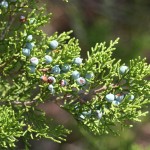Ashe Juniper, Blueberry Juniper, Ashe's Juniper
Juniperus ashei J. Buchholz
Cupressaceae (Cypress family)
Description
This evergreen tree is a perennial, cool- and warm-season native. It is commonly called cedar but is not a true cedar. Ashe Juniper produces limbs from the main trunk that are generally straight and are used commercially as fence posts. It rarely grows over 30 ft or 9 m tall. The bark is thin, easily shreds, and is dark brown or gray. This plant has a strong taproot system as well as extensive lateral roots throughout the soil. The slender leaves are sharp-pointed, each with a gland on the back that can be round or elliptical and pink or greenish. On long leaves, these glands are elongated and tapering. From seedling to 2 years old, Ashe Juniper bears leaves that are awl-shaped or needlelike. Male trees can become golden in the winter from their pollen which causes an allergic reaction for some people. The light to dark blue berries grow on female trees. Ashe Juniper provides fair grazing for wildlife and poor grazing for livestock. The berries are consumed by many species of birds and small mammals. The leaves are occasionally consumed by deer and goats. The bark can also be used as nesting material for some bird species. Ashe Juniper serves as a cover for birds and mammals including the white-tailed deer.Habitat
The distribution of Ashe Juniper is limited to a few states in the southwestern United States and parts of Mexico. An aggressive invader, Ashe Juniper is found mostly on limestone and shallow, rocky soils in Texas. It is commonly found in the Central Texas region on the Edwards Plateau. Native habitat includes grasslands, shrublands, woody uplands, riparian areas, and upland deciduous forests of Central Texas.Images
Plant Characteristics
Seed Type: Fruit/Berry
Duration: Perennial
Stem Texture: Hairless/Smooth
Growth Habit: Shrub (Woody)
Season: Evergreen
Distribution
 : 04 - Blackland Prairies, 05 - Cross Timbers and Prairies, 06 - South Texas Plains, 07 - Edwards Plateau, 08 - Rolling Plains, 10 - Trans-Pecos
: 04 - Blackland Prairies, 05 - Cross Timbers and Prairies, 06 - South Texas Plains, 07 - Edwards Plateau, 08 - Rolling Plains, 10 - Trans-Pecos
Distributions
Distribution refers to the ecological region in Texas that a plant has been found. You can also view a clickable map.
Book: Brush and Weeds of Texas Rangelands (B-6208)
Collection: Brush and Weeds






